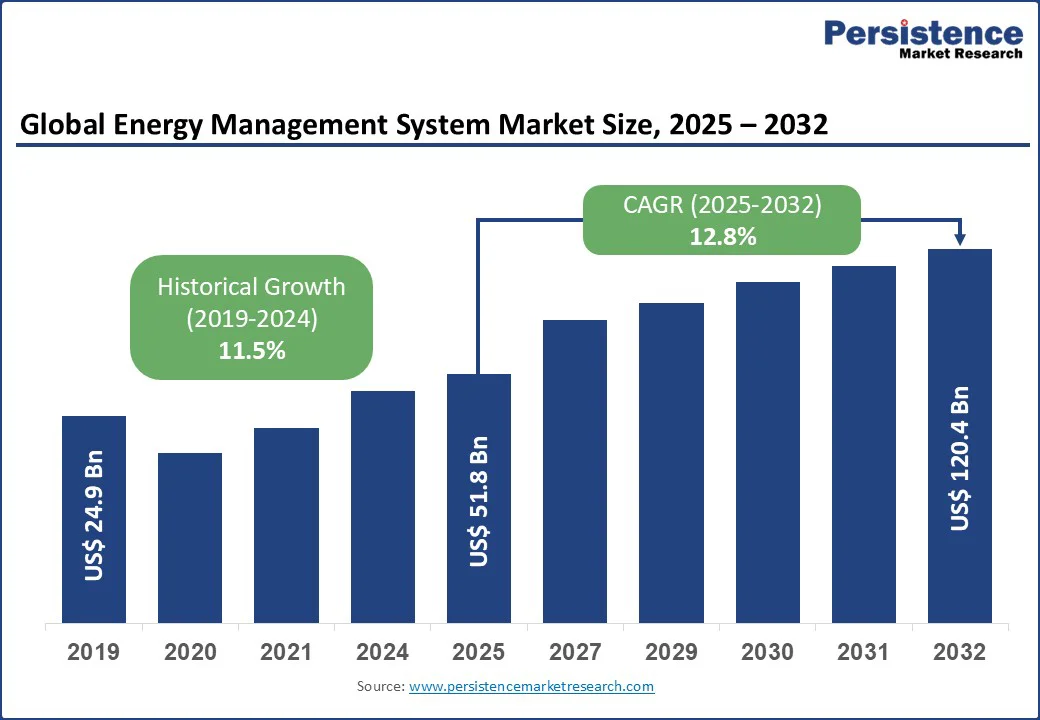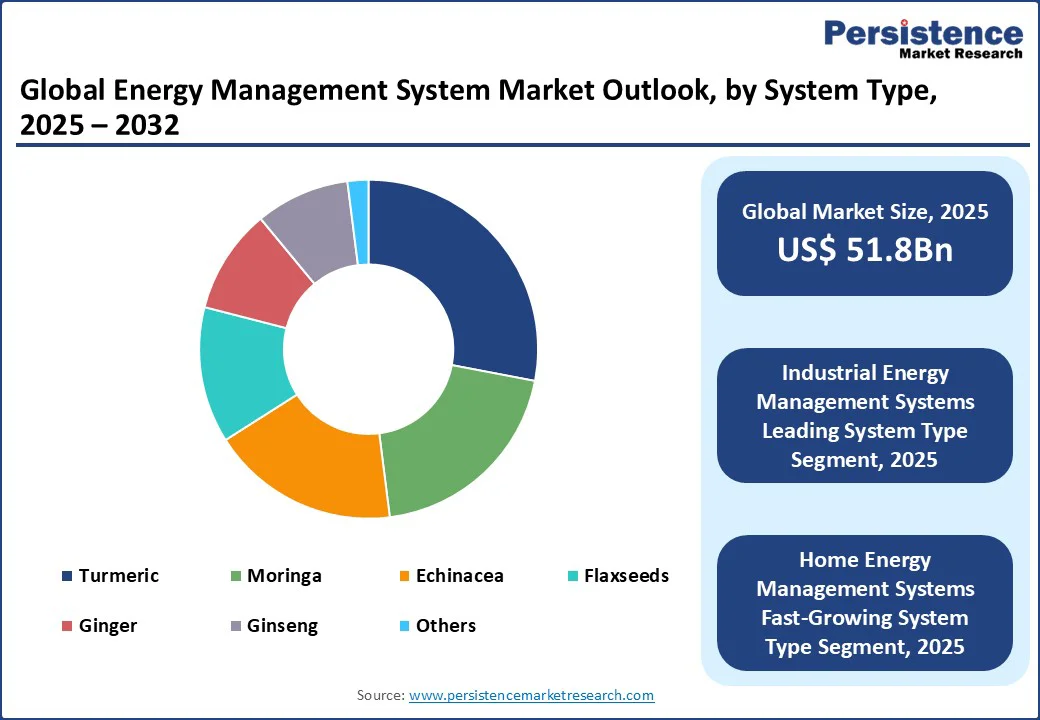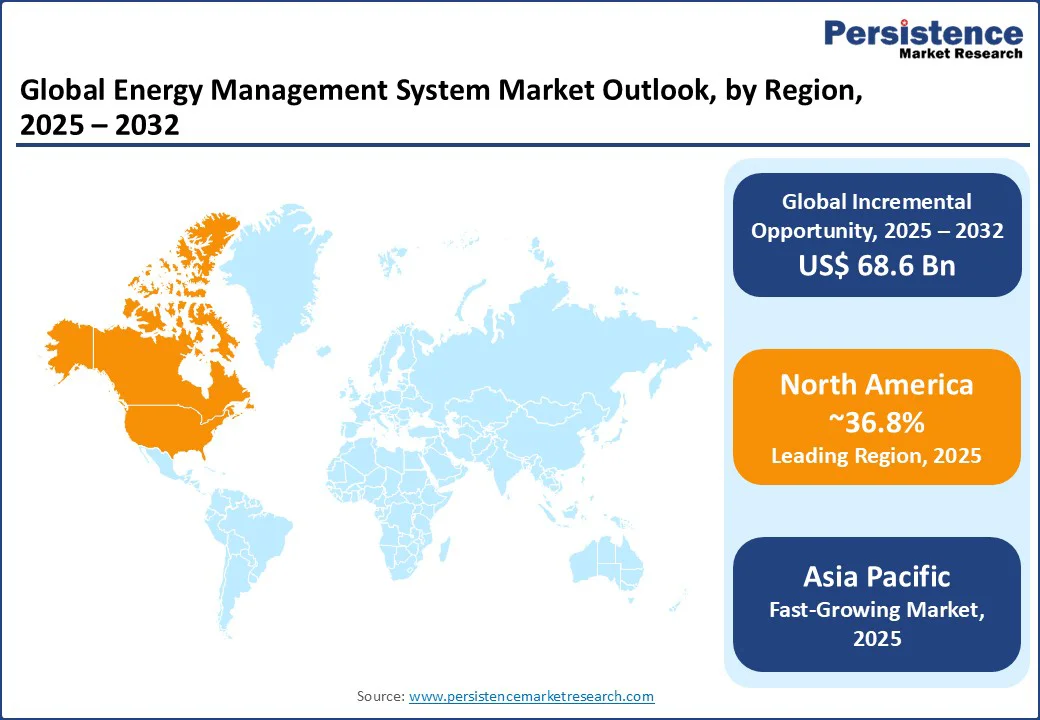ID: PMRREP7042| 178 Pages | 17 Sep 2025 | Format: PDF, Excel, PPT* | Chemicals and Materials

The global energy management system (EMS) market size is likely to be US$51.8 Bn in 2025. It is expected to reach US$120.4 Bn by 2032, achieving a robust CAGR of 12.8% during the forecast period from 2025 to 2032, driven by the increasing need for energy efficiency, rising energy costs, and stringent government regulations promoting sustainability.
These systems, encompassing industrial energy management systems (IEMS are critical for optimizing energy consumption across various sectors.
Key Industry Highlights:

| Key Insights | Details |
|---|---|
| Energy Management System Market Size (2025E) | US$ 51.8Bn |
| Market Value Forecast (2032F) | US$ 120.4Bn |
| Projected Growth (CAGR 2025 to 2032) | 12.8% |
| Historical Market Growth (CAGR 2019 to 2024) | 11.5% |
The growing emphasis on energy efficiency and sustainability is a primary driver of the global EMS market. With global energy consumption projected to increase, according to the International Energy Agency (IEA), industries, buildings, and households are adopting EMS to optimize energy usage and reduce costs.
The rise in energy prices, coupled with government regulations such as the EU’s Energy Efficiency Directive, which mandates a 32.5% energy efficiency improvement by 2030, is pushing organizations to implement advanced EMS solutions.
For instance, China Southern Power Grid committed to 670 billion yuan (US$105 billion) of investment in grid network construction during the 2021-25 period, including clean energy power transmission, intelligent power distribution, and smart power consumption, driving demand for IEMS and BEMS.
The integration of IoT and AI in EMS, offered by companies such as Schneider Electric and Siemens, enables real-time energy monitoring, reducing waste by up to 20% in industrial applications. In emerging markets such as India, initiatives such as the Smart Cities Mission are increasing the adoption of BEMS, ensuring sustained market growth through 2032.
The high initial costs of EMS implementation and integration challenges pose significant restraints to market growth, particularly for small and medium-sized enterprises (SMEs). Advanced EMS solutions, such as IEMS for industrial applications, require substantial investments in hardware, software, and skilled personnel.
Additionally, integrating EMS with existing infrastructure, such as legacy HVAC systems or industrial machinery, often involves complex retrofitting, increasing costs, and deployment time. Stringent data privacy regulations, such as the EU’s General Data Protection Regulation (GDPR), further complicate IoT-based EMS deployments, adding compliance costs. These financial and technical barriers limit market penetration in emerging economies, hindering overall growth through 2032.
The integration of IoT and AI technologies is revolutionizing the Energy Management System (EMS) market by unlocking significant growth opportunities. Smart EMS solutions equipped with advanced sensors and AI-driven analytics enable real-time monitoring and predictive maintenance, leading to enhanced energy efficiency and optimized operational performance.
For example, Honeywell’s Forge Energy Optimization platform leverages AI to reduce energy consumption in commercial buildings by up to 15%, demonstrating tangible energy savings. Similarly, Schneider Electric’s EcoStruxure platform uses IoT to provide real-time energy analytics in industrial settings, minimizing downtime and reducing operational costs.
Government initiatives such as the U.S. Department of Energy’s Grid Modernization Initiative further accelerate the adoption of smart grids and IoT technologies, fostering EMS innovation and infrastructure upgrades.
Leading technology companies such as IBM and Cisco are heavily investing in R&D to develop AI-driven EMS solutions tailored to the needs of both developed and emerging markets. These efforts ensure sustainable, cost-effective energy management, driving robust market expansion through 2032.

North America is a dominant force in the Energy Management System (EMS) market, is projected to account for significant share in 2025, and rank as the second-fastest-growing region. This growth is propelled by a robust industrial sector and widespread adoption of smart technologies across commercial and industrial domains.
The United States leads the charge with ambitious initiatives such as the Grid Modernization Initiative, which allocates US$10.5 billion by 2025 to upgrade grid efficiency, enhance resilience, and integrate renewable energy sources.
The rapid expansion of data centers and the telecom industry, combined with an increase in U.S. e-commerce sales in 2024, further drives demand for Building Energy Management Systems (BEMS) and Industrial Energy Management Systems (IEMS).
Meanwhile, Canada’s focus on sustainable energy, particularly hydropower, supports EMS adoption in the energy sector. Leading companies such as General Electric and Cisco are investing heavily in advanced manufacturing and R&D to develop AI-driven EMS solutions, ensuring continued market growth and technological innovation through 2032.
Europe is the fastest-growing region in energy management systems adoption, driven by strong regulatory frameworks, renewable energy targets, and industrial modernization. Germany leads with the Energiewende initiative, focusing on integrating renewables such as wind and solar into industrial processes and expanding smart energy systems.
The European Union’s Green Deal and Clean Industrial Deal allocate over €1 trillion toward energy efficiency, renewable deployment, and grid modernization by 2030.
France, Spain, and the UK are investing heavily in smart grids and digitization to support EMS growth. The region’s manufacturing, commercial, and public sectors increasingly adopt Building Energy Management Systems (BEMS) and Industrial EMS (IEMS).
Key companies such as Siemens, Schneider Electric, and ABB are expanding tailored EMS solutions for Europe’s complex regulatory and sustainability landscape. Ongoing initiatives in carbon emission reduction and energy efficiency ensure steady EMS market growth through 2032.
Asia Pacific is the second fastest region, driven by rapid urbanization, industrial growth, and government-led energy efficiency initiatives. China, the largest market, benefits from policies such as China Southern Power Grid, committed to 670 billion yuan (US$105 billion) of investment in grid network construction during the 2021-25 period. India’s Smart Cities Mission, with investments of US$100 billion by 2025, drives demand for BEMS and HEMS.
The region’s manufacturing boom, particularly in electronics and automotive sectors, boosts IEMS adoption. Rising disposable incomes and urbanization in Southeast Asia further increase demand for smart home EMS solutions. Local players such as Delta Electronics, alongside global giants such as Siemens and Schneider Electric, capitalize on the region’s growth potential, ensuring dominance through 2032.

The global energy management system market is highly competitive, with key players such as Schneider Electric SE, Honeywell International Inc., Siemens AG, Johnson Controls, Inc., C3.ai, Inc., GridPoint, General Electric, ABB, IBM Corporation, and Cisco Systems, Inc. dominating through innovation and global distribution networks.
Regional players such as Delta Electronics focus on localized offerings in the Asia Pacific. Companies are investing in AI-driven EMS, sustainable solutions, and strategic partnerships to enhance market share, driven by demand for energy-efficient and smart systems.
The Energy Management System market is projected to reach US$51.8 Bn in 2025.
Rising demand for energy efficiency and advancements in IoT and AI-based technologies are the key market drivers for the Energy Management System Market.
The Energy Management System market is poised to witness a CAGR of 12.8% from 2025 to 2032.
The integration of IoT and AI-based EMS solutions is a key market opportunity in the Energy Management System Market.
Schneider Electric SE, Honeywell International Inc., Siemens AG, Johnson Controls, Inc., and ABB are among the key market players.
| Report Attribute | Details |
|---|---|
| Historical Data/Actuals | 2019 - 2024 |
| Forecast Period | 2025 - 2032 |
| Market Analysis | Value: US$ Bn/Mn, Volume: As Applicable |
| Geographical Coverage |
|
| Segmental Coverage |
|
| Competitive Analysis |
|
| Report Highlights |
|
By System Type
By Application
By Component
By End-use
By Region
Delivery Timelines
For more information on this report and its delivery timelines please get in touch with our sales team.
About Author